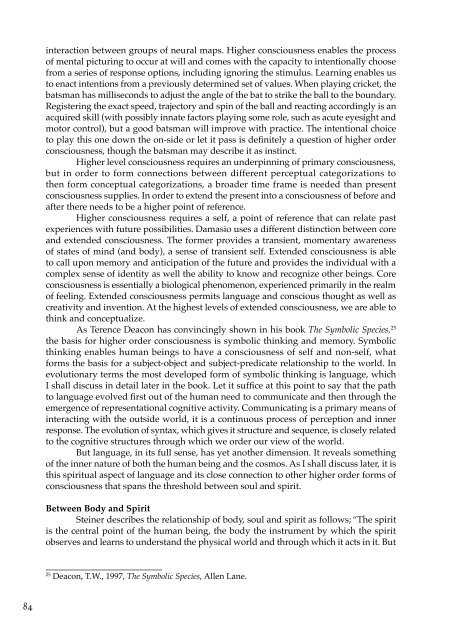The Spirit in Human Evolution - Waldorf Research Institute
The Spirit in Human Evolution - Waldorf Research Institute
The Spirit in Human Evolution - Waldorf Research Institute
You also want an ePaper? Increase the reach of your titles
YUMPU automatically turns print PDFs into web optimized ePapers that Google loves.
<strong>in</strong>teraction between groups of neural maps. Higher consciousness enables the process<br />
of mental pictur<strong>in</strong>g to occur at will and comes with the capacity to <strong>in</strong>tentionally choose<br />
from a series of response options, <strong>in</strong>clud<strong>in</strong>g ignor<strong>in</strong>g the stimulus. Learn<strong>in</strong>g enables us<br />
to enact <strong>in</strong>tentions from a previously determ<strong>in</strong>ed set of values. When play<strong>in</strong>g cricket, the<br />
batsman has milliseconds to adjust the angle of the bat to strike the ball to the boundary.<br />
Register<strong>in</strong>g the exact speed, trajectory and sp<strong>in</strong> of the ball and react<strong>in</strong>g accord<strong>in</strong>gly is an<br />
acquired skill (with possibly <strong>in</strong>nate factors play<strong>in</strong>g some role, such as acute eyesight and<br />
motor control), but a good batsman will improve with practice. <strong>The</strong> <strong>in</strong>tentional choice<br />
to play this one down the on-side or let it pass is def<strong>in</strong>itely a question of higher order<br />
consciousness, though the batsman may describe it as <strong>in</strong>st<strong>in</strong>ct.<br />
Higher level consciousness requires an underp<strong>in</strong>n<strong>in</strong>g of primary consciousness,<br />
but <strong>in</strong> order to form connections between different perceptual categorizations to<br />
then form conceptual categorizations, a broader time frame is needed than present<br />
consciousness supplies. In order to extend the present <strong>in</strong>to a consciousness of before and<br />
after there needs to be a higher po<strong>in</strong>t of reference.<br />
Higher consciousness requires a self, a po<strong>in</strong>t of reference that can relate past<br />
experiences with future possibilities. Damasio uses a different dist<strong>in</strong>ction between core<br />
and extended consciousness. <strong>The</strong> former provides a transient, momentary awareness<br />
of states of m<strong>in</strong>d (and body), a sense of transient self. Extended consciousness is able<br />
to call upon memory and anticipation of the future and provides the <strong>in</strong>dividual with a<br />
complex sense of identity as well the ability to know and recognize other be<strong>in</strong>gs. Core<br />
consciousness is essentially a biological phenomenon, experienced primarily <strong>in</strong> the realm<br />
of feel<strong>in</strong>g. Extended consciousness permits language and conscious thought as well as<br />
creativity and <strong>in</strong>vention. At the highest levels of extended consciousness, we are able to<br />
th<strong>in</strong>k and conceptualize.<br />
As Terence Deacon has conv<strong>in</strong>c<strong>in</strong>gly shown <strong>in</strong> his book <strong>The</strong> Symbolic Species, 25<br />
the basis for higher order consciousness is symbolic th<strong>in</strong>k<strong>in</strong>g and memory. Symbolic<br />
th<strong>in</strong>k<strong>in</strong>g enables human be<strong>in</strong>gs to have a consciousness of self and non-self, what<br />
forms the basis for a subject-object and subject-predicate relationship to the world. In<br />
evolutionary terms the most developed form of symbolic th<strong>in</strong>k<strong>in</strong>g is language, which<br />
I shall discuss <strong>in</strong> detail later <strong>in</strong> the book. Let it suffice at this po<strong>in</strong>t to say that the path<br />
to language evolved first out of the human need to communicate and then through the<br />
emergence of representational cognitive activity. Communicat<strong>in</strong>g is a primary means of<br />
<strong>in</strong>teract<strong>in</strong>g with the outside world, it is a cont<strong>in</strong>uous process of perception and <strong>in</strong>ner<br />
response. <strong>The</strong> evolution of syntax, which gives it structure and sequence, is closely related<br />
to the cognitive structures through which we order our view of the world.<br />
But language, <strong>in</strong> its full sense, has yet another dimension. It reveals someth<strong>in</strong>g<br />
of the <strong>in</strong>ner nature of both the human be<strong>in</strong>g and the cosmos. As I shall discuss later, it is<br />
this spiritual aspect of language and its close connection to other higher order forms of<br />
consciousness that spans the threshold between soul and spirit.<br />
Between Body and <strong>Spirit</strong><br />
Ste<strong>in</strong>er describes the relationship of body, soul and spirit as follows; “<strong>The</strong> spirit<br />
is the central po<strong>in</strong>t of the human be<strong>in</strong>g, the body the <strong>in</strong>strument by which the spirit<br />
observes and learns to understand the physical world and through which it acts <strong>in</strong> it. But<br />
_________________________<br />
25<br />
Deacon, T.W., 1997, <strong>The</strong> Symbolic Species, Allen Lane.<br />
84
















